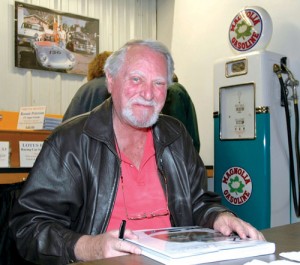By Greg Brown,
“Clive Cussler!” I said, “He writes the Dirk Pitt novels, like “Raise the Titanic” and “Inca Gold.” And he discovered the Confederate submarine, Hunley.”
“That’s right,” said Penny Porter, director of Tucson’s Society of Southwestern Authors annual writers’ conference. “After our original keynote canceled for next week, Clive graciously agreed to speak on short notice. You’re still coming, right?”
“Wouldn’t miss it!” I said, “And I can’t wait to hear Clive Cussler speak. But why are you phoning me?”
“Because we have a problem,” said Penny. “Clive has agreed to present, but he must return home by five o’clock for another engagement. Would you bring him with you in the Flying Carpet? He lives nearby and you could easily get him back before five, right?”
“Spend the day with a famous author?” I replied. “You bet!”
Even my wife Jean was excited. Upon hearing the news, she changed her tune from “boring writers’ conference” to “You’re not going without me!”
With umpteen New York Times best sellers under his belt and more than 120 million books in print, Clive Cussler lives adventures just as exciting as those of his fictional hero, Dirk Pitt. Cussler chases lost shipwrecks. Among some 60 he has found are the Civil War Hunley, first submarine to sink a ship in battle; Carpathia, rescuer of Titanic survivors; and L’Aimable, Robert LaSalle’s seventeenth century ship of exploration.
Upon phoning to make arrangements, I learned that Cussler has aviation blood, too; he served as a C-97 flight engineer during the Korean War. (The C-97 Stratofreighter and Stratotanker were military adaptations of the Boeing Stratocruiser airliner.) My excitement grew as Cussler shared stories about 15-hour round-engine cargo flights from Hawaii to Japan. What’s more, his shipwreck-hunting partner and “Sea Hunters” coauthor, Craig Dirgo, would be joining us for the flight to Tucson.
Upon our meeting at Scottsdale Airport, we found that Cussler is a tall man, with graying hair and a warm handshake. Although I’d described our single-engine Cessna in advance, he appeared surprised to find the Flying Carpet nestled uncomfortably between corporate jets, like a gnat among eagles. But any concerns seemed forgotten after takeoff, when Cussler and Dirgo watched jets land beneath us at Phoenix Sky Harbor Airport.
Sky Harbor: With these passengers on board, the name brought to mind ships—and shipwrecks! I could scarcely contain myself until departing congested airspace so we could talk. When I did raise the topic, Cussler and Dirgo gladly shared stories.
One assumes that navies of experts would be required to find lost ships, but it turns out that for their search expeditions, Cussler and Dirgo command just a few people and a rented boat. Months of research are required before exploration begins; then it takes a lucky combination of skill and dogged persistence to find ships lost for decades or centuries.
The search for a lost Confederate blockade runner, for example, was fruitless until Cussler determined that methods for reckoning latitude and longitude had changed slightly following the Civil War. After applying that correction to 150-year-old charts, he found the wreck. It seemed odd for a moment, discussing Confederate shipwrecks over the Arizona desert, but then our windshield filled with Picacho Peak, the site of the westernmost battle of the Civil War. Funny how history ties things together.
Cussler next turned from ships to the search for a mysterious locomotive; lost in a Colorado river, it simply couldn’t be found. How, the men wondered, could a locomotive disappear from beneath the bridge where it fell? Clever sleuthing turned up a 100-year-old insurance scam; it turned out that after collecting payment, the owners had secretly salvaged the wrecked locomotive for use under a different name.
I almost dropped my chart when the team brought up their then-latest project—an aerial mystery. Only days before his 1927 transatlantic flight, Charles Lindbergh learned that two World War I flying heroes, Charles Nungesser and François Coli, had departed Paris for New York in their Levasseur biplane, L’Oiseau Blanc.

Craig asked if we might circle “the boneyard,” that monstrous graveyard at Davis-Monthan Air Force Base where old military airplanes go to die.
Lindbergh thought he’d lost the race, but as it turned out, Nungesser and Coli disappeared without a trace. Many historians believe that L’Oiseau Blanc went down off the coast of France, but Cussler believed it had successfully crossed the Atlantic and crashed in the United States. Finding it would rewrite history. (Three attempts later, Cussler’s team has yet to unravel the mystery.)
By now we were approaching Tucson, and Craig Dirgo asked if we might circle “the boneyard,” that monstrous graveyard at Davis-Monthan Air Force Base where old military airplanes go to die.
“It’s in one of my books,” said Dirgo. “I want to see from the air that I’ve described it properly.”
“Circle as long as you like,” offered Tucson approach when asked, so the four of us ogled neat rows of fighters, bombers and transports. Try as we might, however, we couldn’t locate a single C-97 from Cussler’s Air Force days.
“Too old even for the junkyard,” he said, as we banked toward Tucson International.
Soon, the famous author was enthralling writers at the conference, while host Penny Porter beamed from the sidelines. But for us the adventure was only half over; on the flight home, we learned how a master conceives fiction, and where Dirk Pitt got his name. We circled Cussler’s house before landing, and afterwards, he even honored me with a compliment on my piloting.
But on this trip, I was, in a sense, just a lucky passenger—on a captivating journey through history, piloted by a master storyteller. Of course, that’s exactly why Clive Cussler is so successful, though Jean and I did agree on the way home never to become the subject of one of his books. For much as we enjoyed participating in a very minor Clive Cussler adventure, we just didn’t like the sound of “Raise the Flying Carpet.”
Author of numerous books and articles, Greg Brown is also a columnist for AOPA Flight Training magazine. Read more of his tales in “Flying Carpet: The Soul of an Airplane,” available through your favorite bookstore, pilot shop, or online catalog, and visit [http://www.gregbrownflyingcarpet.com].













